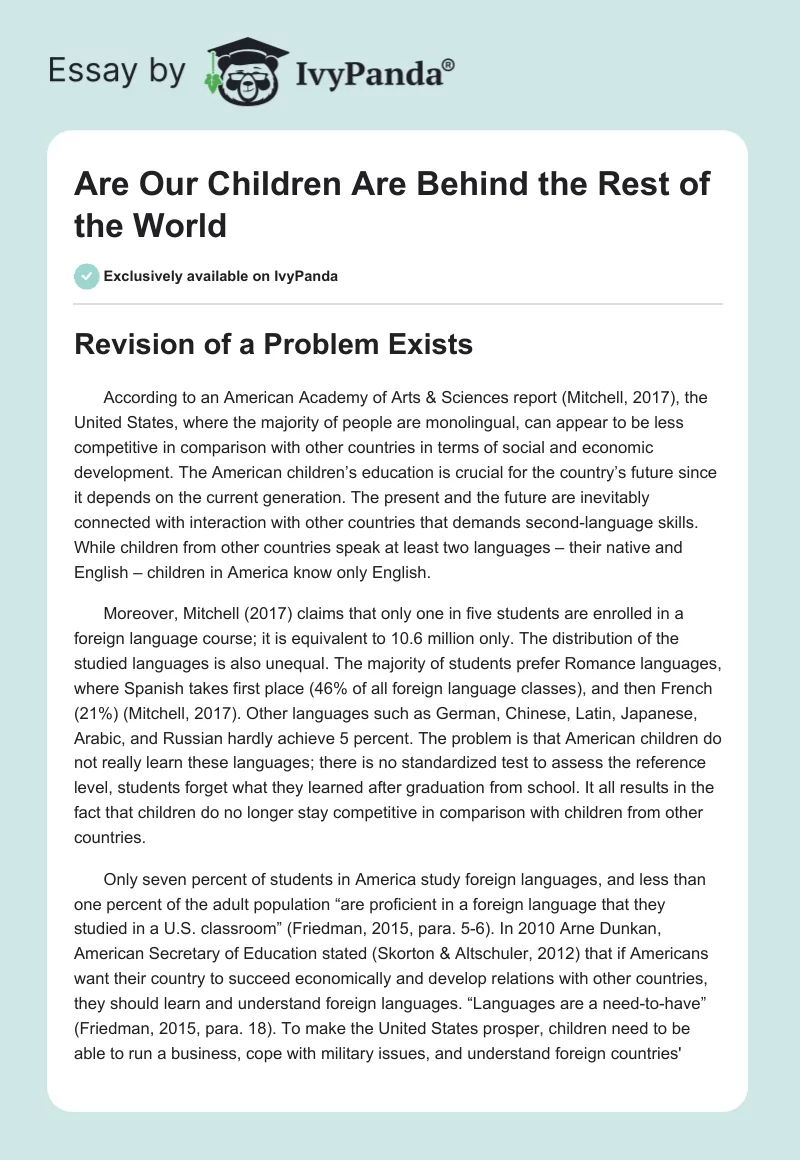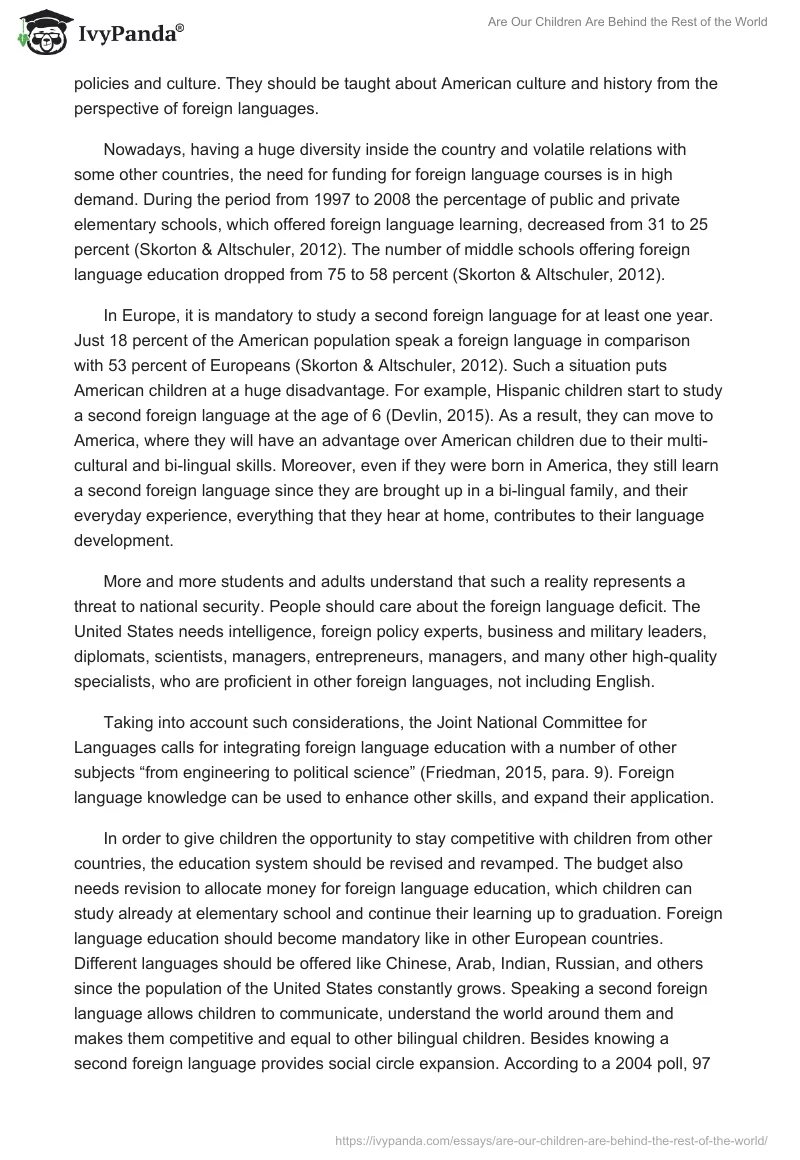Revision of a Problem Exists
According to an American Academy of Arts & Sciences report (Mitchell, 2017), the United States, where the majority of people are monolingual, can appear to be less competitive in comparison with other countries in terms of social and economic development. The American children’s education is crucial for the country’s future since it depends on the current generation. The present and the future are inevitably connected with interaction with other countries that demands second-language skills. While children from other countries speak at least two languages – their native and English – children in America know only English.
Moreover, Mitchell (2017) claims that only one in five students are enrolled in a foreign language course; it is equivalent to 10.6 million only. The distribution of the studied languages is also unequal. The majority of students prefer Romance languages, where Spanish takes first place (46% of all foreign language classes), and then French (21%) (Mitchell, 2017). Other languages such as German, Chinese, Latin, Japanese, Arabic, and Russian hardly achieve 5 percent. The problem is that American children do not really learn these languages; there is no standardized test to assess the reference level, students forget what they learned after graduation from school. It all results in the fact that children do no longer stay competitive in comparison with children from other countries.
Only seven percent of students in America study foreign languages, and less than one percent of the adult population “are proficient in a foreign language that they studied in a U.S. classroom” (Friedman, 2015, para. 5-6). In 2010 Arne Dunkan, American Secretary of Education stated (Skorton & Altschuler, 2012) that if Americans want their country to succeed economically and develop relations with other countries, they should learn and understand foreign languages. “Languages are a need-to-have” (Friedman, 2015, para. 18). To make the United States prosper, children need to be able to run a business, cope with military issues, and understand foreign countries’ policies and culture. They should be taught about American culture and history from the perspective of foreign languages.
Nowadays, having a huge diversity inside the country and volatile relations with some other countries, the need for funding for foreign language courses is in high demand. During the period from 1997 to 2008 the percentage of public and private elementary schools, which offered foreign language learning, decreased from 31 to 25 percent (Skorton & Altschuler, 2012). The number of middle schools offering foreign language education dropped from 75 to 58 percent (Skorton & Altschuler, 2012).
In Europe, it is mandatory to study a second foreign language for at least one year. Just 18 percent of the American population speak a foreign language in comparison with 53 percent of Europeans (Skorton & Altschuler, 2012). Such a situation puts American children at a huge disadvantage. For example, Hispanic children start to study a second foreign language at the age of 6 (Devlin, 2015). As a result, they can move to America, where they will have an advantage over American children due to their multi-cultural and bi-lingual skills. Moreover, even if they were born in America, they still learn a second foreign language since they are brought up in a bi-lingual family, and their everyday experience, everything that they hear at home, contributes to their language development.
More and more students and adults understand that such a reality represents a threat to national security. People should care about the foreign language deficit. The United States needs intelligence, foreign policy experts, business and military leaders, diplomats, scientists, managers, entrepreneurs, managers, and many other high-quality specialists, who are proficient in other foreign languages, not including English.
Taking into account such considerations, the Joint National Committee for Languages calls for integrating foreign language education with a number of other subjects “from engineering to political science” (Friedman, 2015, para. 9). Foreign language knowledge can be used to enhance other skills, and expand their application.
In order to give children the opportunity to stay competitive with children from other countries, the education system should be revised and revamped. The budget also needs revision to allocate money for foreign language education, which children can study already at elementary school and continue their learning up to graduation. Foreign language education should become mandatory like in other European countries. Different languages should be offered like Chinese, Arab, Indian, Russian, and others since the population of the United States constantly grows. Speaking a second foreign language allows children to communicate, understand the world around them and makes them competitive and equal to other bilingual children. Besides knowing a second foreign language provides social circle expansion. According to a 2004 poll, 97 percent of dating agencies asked applicants a question, whether they spoke foreign languages (Butler, 2011). It turned out that being bilingual makes a person look more intelligent, worldly, attentive, and gentle than English-only speakers.
The solution to Problem and Advantages
Researches show that bilingual students “outperform monolinguals in the areas of pattern recognition, divergent thinking, and problem-solving” (Maurer, 2016, para. 11). In this case, realizing the benefits of bilingualism, it is important to find a solution how to solve the problem of a foreign language deficit. The possible solution consists of 3 stages, which will be discussed further.
To begin with, it appears that the education system should become a driving force in providing people with the idea of a need for second foreign language knowledge. “Schools are where America needs to start” (Riehl, 2016, p. 53). The educational system in the United States needs to understand the importance of foreign language learning and build it into the mandatory schedule for all students. After this stage, it is important to allocate money to public schools, so that they will be able to offer more language classes. Once it is all settled, better teaching methods and organization of the foreign language classes should be discussed and accepted. Such a strategy will allow solving this issue.
The strategy suggested above has several advantages
First, regarding the recognizing stage, it is to some extent a moral or ethical advantage. This stage helped to fight the reasons, which make Americans ignore foreign languages. Americans need to realize the value of foreign languages and understand that English is not the only important language in the world. Recognizing will help to get rid of prejudices, which prevent the American population from learning a foreign language (Riehl, 2016). This stage might foster tolerance in children to an unknown country, its people, and their culture. Besides, people would analyze the benefits of foreign languages to augment and enhance other skills that increase their chances to receive a good job, because the reality is obvious: “bilingual applicants are routinely at the top of the pile” (Butler, 2011, para. 6).
Secondly, the suggested solution would have an economic advantage. The government needs to think of new possible educational programs, revise, and change its budget in order to allocate money to the educational facilities so that they could offer more classes in foreign languages. In such a case, the American government will be able to conduct an analysis, which results will help to determine what kind of financial support is needed. Besides, such languages as Bengali, Vietnamese, Farsi, and Indonesian are very essential for American economic and strategic interests. If these languages were taught at school, it would considerably contribute to the economic state of the United States since its uneasy relations with these countries would be improved. Moreover, as a counter to the general opinion that tutoring might be too expensive, one of the solutions that can be applied at school is dual-language instruction, where a number of subjects are taught in two languages, thus eliminating the need to hire another tutor (Friedman, 2015). Besides, such dual-language programs are more cost-effective since they do not demand extra materials and pay for them for the language instruction.
In terms of improving teaching methods and organization of the foreign language classes, the structure and innovations suggested further would have a big advantage over the current ways of teaching that would allow achieving a higher level of knowledge and second language skills. Here, it should be considered that foreign language studying should begin in elementary school, so that is at the age of 5–15 because some areas of the brain are still forming at this age. Another point is that the structure of a classroom should also be changed. The class must be small, holding ten students per class (Riehl, 2016). This would provide both individual attention and total participation. In such small classes, professors could easily identify the students who need help, and all students would have equal time to participate in the lesson. Small classes are also convenient for open discussions.
It means that the topics of these discussions are not connected with language concepts that would make all students participate in a conversation (Riehl, 2016). Besides, foreign language classes need various exercises and activities that would be not typical for other classes that would make such classes more interesting in the subject. One of the ways to make it is to use media. Podcasts, music, video, movies, newspaper, and others could contribute to the student’s interest and make them better understand the language and culture of other countries (Riehl, 2016). The last point here is that students must avoid speaking their native language during a second foreign language class. It does not benefit them.
Conclusion
To sum up, the solution offered above is directed at the revision and improvement of three sides related to the educational system. The first is providing students with an understanding of the importance of foreign languages education through the educational system. The second stage is to assess the budget and allocate money to schools. The last stage is to improve teaching methods and the structure of classes. Each stage of the solution has its advantages. Thus, due to the first stage, students become more tolerant and open-minded. The second stage to some extent allows reducing costs of education. Finally, in the third stage, the proposed structure of classes allows achieving a new level of knowledge and improving second language skills.
It is crucial to provide children with an opportunity to study a second foreign language in order to stay competitive and create a bright future for the country. Having English as a lingua franca of international business, politics, and others does not mean that studying foreign languages is a waste of time and a useless activity. Each country’s successful development depends on the constant interaction with others. Language, in this case, is not only a means of communication but also a means of the country’s success.
References
Butler, M. (2011). Learning a second language: Weighing pros and cons. Web.
Devlin, K. (2015). Learning a foreign language a ‘must’ in Europe, not so in America. Web.
Friedman, A. (2015). America’s lacking language skills: Budget cuts, low enrollments, and teacher shortages mean the country is falling behind the rest of the world. The Atlantic. Web.
Maurer, T. (2016). Does America’s foreign language deficit matter? Ask Google translate. Web.
Mitchell, C. (2017). How much foreign language is being taught in US schools?Education Week. Web.
Riehl, A. B. (2016). Americans’ foreign language deficit and possible solutions. Web.
Skorton, D., & Altschuler, G. (2012). America’s foreign language deficit.Forbes. Web.


